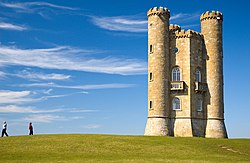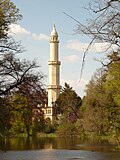Folly
In architecture, a folly is a building usually constructed strictly for aesthetic pleasure.[1] Originally, buildings were made to provide shelter or to house people. Follies are just decoration; they no longer have a building's original function. They were first constructed to put accents into parks and estates. "Folly" is used in the sense of fun or light-heartedness, not in the sense of something ill-advised.
Characteristics
In general, follies have the following properties:
- They are buildings, or parts of buildings. This makes them clearly different from other garden ornaments such as sculpture.
- They have no purpose other than as an ornament. Often they have some of the appearance of a building constructed for a particular purpose, but this appearance is a sham.
- They are purpose-built. Follies are deliberately built as ornaments.
- They are often eccentric in design or construction. This is not strictly necessary; however, it is common for these structures to call attention to themselves through unusual details or form.
- There is often an element of fakery in their construction. Perhaps the best example of this is the make-believe ruin: a folly which pretends to be the remains of an old building but which was in fact constructed in that state.
In England, these structures are also called "eye-catchers". This points to their basically decorative nature.
Related types
Follies fall within the general realm of fanciful and impractical architecture, and whether a particular structure is a folly is sometimes a matter of opinion. However, there are several types which are related but which can be distinguished from follies.
- Fantasy and novelty buildings are essentially the converse of follies. Follies often look like real, usable buildings, but never are; novelty buildings are usable, but have fantastic shapes. The many American shops and water towers in the shapes of commonplace items, for example, are not properly follies.
- Eccentric structures may resemble follies, but the mere presence of eccentricity is not proof that a building is a folly. Many mansions and castles are quite eccentric, but being purpose-built to be used as residences, they are not properly follies.
- Some structures are popularly referred to as "follies" because they failed to fulfill their intended use. Their design and construction may be foolish, but in the architectural sense, they are not follies.
- Visionary art structures frequently blur the line between artwork and folly, if only because it is rather often hard to tell what intent the artist had. The word "folly" carries the connotation that there is something frivolous about the builder's intent, and it is hard to say whether a structure like the Watts Towers was constructed "seriously". Some works (such as the massive complex by Ferdinand Cheval) are considered as follies because they are in the form of useful buildings, but are plainly constructions of extreme and intentional impracticality.
- Amusement parks, fairgrounds, and expositions often have fantastical buildings and structures. Some of these are follies, and some are not; the distinction, again, comes in their usage. Shops, restaurants, and other amusements are often housed in strikingly odd and eccentric structures, but these are not follies. On the other hand, fake structures which serve no other purpose than decoration are also common, and these are follies.
History
Follies began as decorative accents on the great estates of the late 16th and early 17th centuries but they flourished especially in the two centuries which followed. Many estates were blessed with picturesque ruins of monastic houses and (in Italy) Roman villas; others, lacking such buildings, constructed their own sham versions of these romantic structures. Such structures were often dubbed "[name of architect or builder]'s Folly", after the single individual who commissioned or designed the project. However, very few follies are completely without a practical purpose. Apart from their decorative aspect, many originally had a use which was lost later, such as hunting towers. Follies are misunderstood structures, according to The Folly Fellowship, a charity that exists to celebrate the history and splendour of these often neglected buildings.
Follies are often found in parks or large grounds of houses and stately homes. Some were deliberately built to look partially ruined. They were especially popular from the end of the 16th century to the 18th century. Theme parks and world's fairs have often contained "follies", although such structures do serve a purpose of attracting people to those parks and fairs.
Famine Follies
The Irish Potato Famine of 1845-49 led to the building of several follies. The society of the day held that laissez faire, not a welfare state, was the appropriate form of civil management. The concept of a welfare state was a century away, and at that time reward without labour, even to those in need, was seen as misguided. However, to hire the needy for work on useful projects would deprive existing workers of their jobs. Thus, construction projects termed "famine follies" came to be built. These include: roads in the middle of nowhere, between two seemingly random points; screen and estate walls; piers in the middle of bogs; etc.[2]
Examples
Follies can be found worldwide, but there seem to be many in Great Britain.


France
- Désert de Retz, folly garden in Chambourcy near Paris, France (18th century)
- Parc de la Villette in Paris has a number of modern follies by architect Bernard Tschumi.
- Ferdinand Cheval in Châteauneuf-de-Galaure, built what he called an Ideal Palace, seen as an example of naive architecture.
Malaysia
Hungary
- Bory Castle at Székesfehérvár
- Taródi Castle at Sopron
- Vajdahunyad vára in the City Park of Budapest
India
Ireland
Italy
- The Bomarzo Gardens
Romania
Russia
- Ruined towers in Peterhof, Tsarskoe Selo, Gatchina, and Tsaritsino
- Creaking Pagoda and Chinese Village in Tsarskoe Selo
- Dutch Admiralty in Tsarskoe Selo
Ukraine
- Swallow's Nest near Yalta
United Kingdom
- Ashton Memorial, Lancaster, England
- Beckford's Tower, Somerset, England
- Broadway Tower, The Cotswolds, England
- Bettisons Folly, Hornsea, England
- Black Castle Public House, Bristol, England
- The Cage at Lyme Park, Cheshire, England
- The Castle at Roundhay Park, Leeds, England
- Clavell Tower, Dorset, England
- Clytha Castle Monmouthshire
- The Caldwell Tower, Lugton, Renfrewshire, Scotland.
- Dunmore Pineapple, Falkirk, Scotland
- Faringdon Folly, Faringdon, Oxfordshire
- Flounder's Folly, Shropshire, England
- The Folly Tower at Pontypool, Wales
- Fonthill Abbey, Wiltshire, England
- Fort Belvedere, Surrey, England
- Freston Tower, near Ipswich, Suffolk
- Gothic Tower at Goldney Hall, Bristol
- The Great Pagoda at the Royal Botanic Gardens, Kew, London¨
- Gwrych Castle, one of Europe's largest follies, Abergele, North Wales
- Hawkstone Park, follies and gardens in Shropshire, England
- Hume Castle. Berwickshire, Scotland
- King Alfred's Tower, Stourhead, Wiltshire, England
- McCaig's Tower, Oban, Scotland
- Mow Cop Castle, Cheshire, England
- National Monument, Edinburgh, Scotland
- Old John, Bradgate Park, Leicestershire, England
- Penshaw Monument, Penshaw, Sunderland, England
- Perrott's Folly, Birmingham, England
- Pope's Grotto, Twickenham, south west London, England.
- Portmeirion, Wales
- Rushton Triangular Lodge, Northamptonshire (16th century)
- Severndroog Castle, Shooter's Hill, south-east London
- Stowe School has several follies in the grounds
- Sway Tower, New Forest, England
- Tattingstone Wonder, near Ipswich, Suffolk
- The Temple near Castle Semple Loch, Renfrewshire, Scotland.
- Wentworth Follies, Wentworth, South Yorkshire
- Williamson's tunnels, probably the largest underground folly in the world, Liverpool, England
United States
Folly Media
Broadway Tower, Worcestershire, England
The Dunmore Pineapple in Scotland (attributed to William Chambers)
Built in 1912, the Swallow's Nest is one of the Neo-Gothic châteaux fantastiques in Crimea.
Hagley Castle is in the grounds of Hagley Hall. It was built by Sanderson Miller for George, Lord Lyttelton in the middle of the 18th century to look like a small ruined medieval castle.
The Pantheon at Stourhead estate
The Temple of Philosophy at Ermenonville in Oise, France
Roman ruin, Schönbrunn, Austria
The minaret in the Lednice–Valtice Complex, Czech Republic, was built by the House of Liechtenstein between 1797 and 1804.
Other websites
- The Folly Fellowship- An organization which celebrates architectural follies
- Follies in the English Landscape
- Follies and Monuments - A comprehensive catalogue of Follies within the UK
- Images of follies on Odd-stuff! Archived 2009-09-02 at the Wayback Machine
- European Follies Archived 2006-07-11 at the Wayback Machine - Book to be published 2007
References
- ↑ "folly (architecture) -- Britannica Online Encyclopedia". www.britannica.com. Retrieved 2009-05-24.
- ↑ Howley, James. 1993. The Follies and Garden Buildings of Ireland. New Haven: Yale University Press. ISBN 0-300-05577-3
Bibliography
- Barton, Stuart Monumental Follies Lyle Publications, 1972
- Folly Fellowship, The Follies Magazine, published quarterly
- Folly Fellowship, The Follies Journal, published annually
- Folly Fellowship, The Foll-e, an electronic bulletin published monthly and available free to all
- Hatt, E. M. Follies National Benzole, London 1963
- Headley, Gwyn & Meulenkamp, Wim, Follies Grottoes & Garden Buildings, Aurum Press, London 1999
- Headley, Gwyn & Meulenkamp, Wim, Follies — A Guide to Rogue Architecture, Jonathan Cape, London 1990
- Headley, Gwyn & Meulenkamp, Wim, Follies — A National Trust Guide, Jonathan Cape, London 1986
- Headley, Gwyn Architectural Follies in America, John Wiley & Sons, New York 1996
- Howley, James The Follies and Garden Buildings of Ireland Yale University Press, New Haven & London, 1993
- Jackson, Hazelle Shellhouses and Grottoes, Shire Books, England, 2001
- Jones, Barbara Follies & Grottoes, Constable, London 1953 & 1974
- Meulenkamp, Wim Follies — Bizarre Bouwwerken in Nederland en België, Arbeiderpers, Amsterdam, 1995














